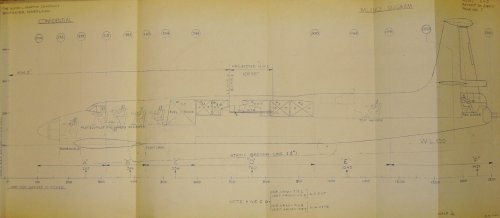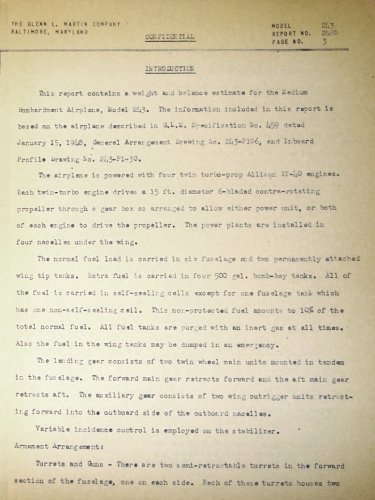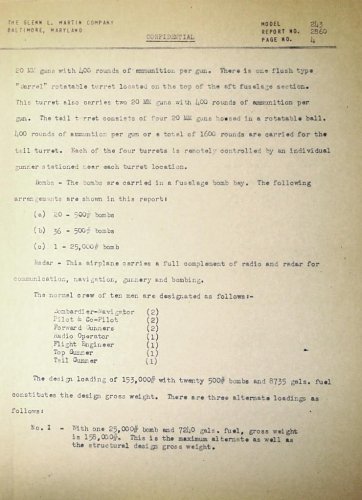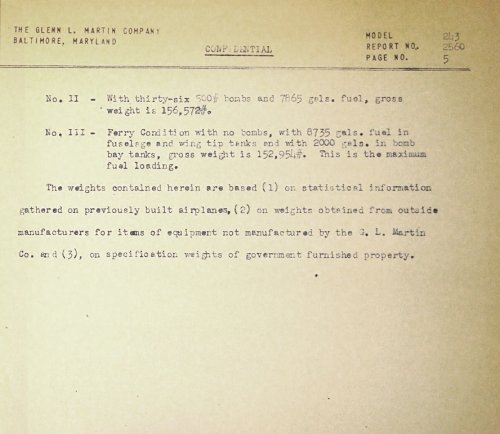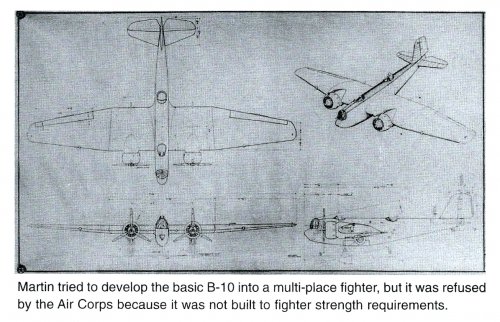- Joined
- 25 June 2009
- Messages
- 14,753
- Reaction score
- 6,147
The following information is taken from Martin Engineering Report No. 2860 dated January 23, 1948 pertaining to a "Medium Bombardment Airplane" designated the Model 243. As I do not have any picture of the project but the basic cutaway profile attached below, I elected not to create a separate topic for it. The ill-fated Allison T-40 was a U.S. Navy program, and the fact that this type was to use an experimental version of it further indicates that this could only be a Navy project, although no customer is specified here. Of course, the aircraft is reminiscent of the general configuration of the Lockheed Neptune but it came a little too late to be a contender for it, so I'm at a loss to say whether it was a spontaneous proposal from Martin as an alternative just in case the Neptune didn't deliver, or an answer to a specific tender (and if so, which one it could be). Any comments and opinions will be appreciated!
Engine:
The airplane was scheduled to be powered by four twin turbo-prop Allison XT-40 engines, each driving a 15 ft. diameter 6-bladed contra-rotating propeller through a gear box so arranged to allow either power unit, or both of each engine to drive the propeller. The power plants were installed in four nacelles under the wing.
Fuel:
The normal fuel load was carried in six fuselage and two permanently attached wing tip tanks. Extra fuel was carried in four 500 gal. bomb-bay tanks. All of the fuel was carried in self-sealing cells except for one fuselage tank which had non self-sealing cell. This non-protected fuel amounted to 10% of the total normal fuel. All fuel tanks were purged with an inert gas at all times. Also the fuel in the wing tip tanks could be dumped in an emergency.
Landing gear:
The landing gear consisted of two twin wheel main units mounted in tandem in the fuselage. The forward main gear retracted forward and the aft main gear retracted aft. The auxiliary gear consisted of two wing outrigger units retracting forward into the outboard side of the outboard nacelles.
Controls:
Variable incidence control was employed on the stabilizer.
Armament arrangement:
Turrets and guns – There were two semi-retractable turrets in the forward section of the fuselage, one on each side. Each of these turrets housed two 20 MM guns with 400 rounds of ammunition per gun. There was one flush type "Barrel" rotatable turret located on the top of the aft fuselage section. This turret also carried two 20 MM guns with 400 rounds of ammunition per gun. The tail turret consisted of four 20 MM guns housed in a rotatable ball. 400 rounds of ammunition per gun or a total of 1600 rounds were carried for the tail turret. Each of the four turrets was remotely controlled by an individual gunner stationed near each turret location.
Bombs – The bombs were carried in a fuselage bomb bay. The following arrangements were shown in this report:
(a) 20 - 500 lb. bombs
(b) 36 - 500 lb. bombs
(c) 1 - 25,000 lb. bomb
Radar:
The airplane carried a full complement of radio and radar for communication, navigation, gunnery and bombing.
Crew:
The normal crew of ten men were designated as follows: Bombardier-Navigator (2); Pilot & Co-Pilot (2); Forward Gunners (2); Radio Operator (1); Flight Engineer (1); Top Gunner (1); Tail Gunner (1).
Loading:
The design loading of 153,000 lb. with twenty 500 lb. bombs and 8735 gals. fuel constituted the design gross weight. There were three alternate loadings as follows:
Engine:
The airplane was scheduled to be powered by four twin turbo-prop Allison XT-40 engines, each driving a 15 ft. diameter 6-bladed contra-rotating propeller through a gear box so arranged to allow either power unit, or both of each engine to drive the propeller. The power plants were installed in four nacelles under the wing.
Fuel:
The normal fuel load was carried in six fuselage and two permanently attached wing tip tanks. Extra fuel was carried in four 500 gal. bomb-bay tanks. All of the fuel was carried in self-sealing cells except for one fuselage tank which had non self-sealing cell. This non-protected fuel amounted to 10% of the total normal fuel. All fuel tanks were purged with an inert gas at all times. Also the fuel in the wing tip tanks could be dumped in an emergency.
Landing gear:
The landing gear consisted of two twin wheel main units mounted in tandem in the fuselage. The forward main gear retracted forward and the aft main gear retracted aft. The auxiliary gear consisted of two wing outrigger units retracting forward into the outboard side of the outboard nacelles.
Controls:
Variable incidence control was employed on the stabilizer.
Armament arrangement:
Turrets and guns – There were two semi-retractable turrets in the forward section of the fuselage, one on each side. Each of these turrets housed two 20 MM guns with 400 rounds of ammunition per gun. There was one flush type "Barrel" rotatable turret located on the top of the aft fuselage section. This turret also carried two 20 MM guns with 400 rounds of ammunition per gun. The tail turret consisted of four 20 MM guns housed in a rotatable ball. 400 rounds of ammunition per gun or a total of 1600 rounds were carried for the tail turret. Each of the four turrets was remotely controlled by an individual gunner stationed near each turret location.
Bombs – The bombs were carried in a fuselage bomb bay. The following arrangements were shown in this report:
(a) 20 - 500 lb. bombs
(b) 36 - 500 lb. bombs
(c) 1 - 25,000 lb. bomb
Radar:
The airplane carried a full complement of radio and radar for communication, navigation, gunnery and bombing.
Crew:
The normal crew of ten men were designated as follows: Bombardier-Navigator (2); Pilot & Co-Pilot (2); Forward Gunners (2); Radio Operator (1); Flight Engineer (1); Top Gunner (1); Tail Gunner (1).
Loading:
The design loading of 153,000 lb. with twenty 500 lb. bombs and 8735 gals. fuel constituted the design gross weight. There were three alternate loadings as follows:
- No. I – With one 25,000 lb. bomb and 7240 gals. fuel, gross weight was 158,000 lb. This was the maximum alternate as well as the structural design gross weight.
- No. II – With thirty-six 500 lb. bombs and 7865 gals. fuel, gross weight was 156,872 lb.
- No. III – Ferry condition with no bombs, with 8735 gals. fuel in fuselage and wing tip tanks and with 2000 gals. in bomb bay tanks, gross weight was 152,954 lb. This was the maximum fuel loading.

